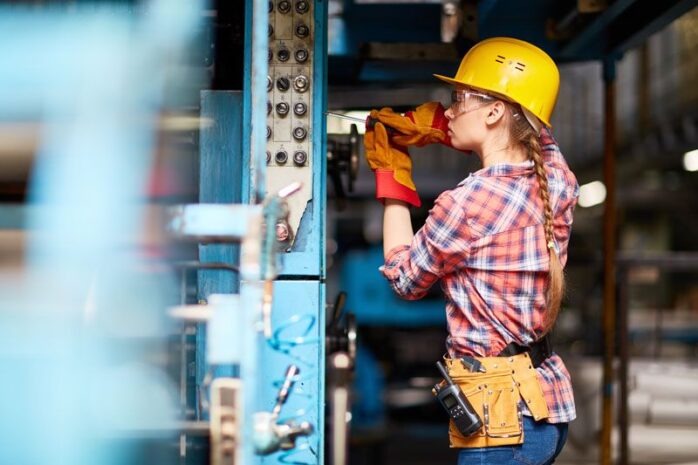
The construction industry hires approximately 7.6 million employees, making it one of the largest sectors in the US economy. Due to the nature of construction work, project managers often have to deal with large teams.
It can often be overwhelming to manage such a big workforce, but thankfully, there are some key things you can do to build a strong construction workforce.
One of them is to use workforce management software like Bridgit. Offering real-time visibility and seamless integration, the software takes the mental gymnastics out of workforce management.
But what else can you do besides using workforce management software? Let’s look at the fine print for creating a solid construction workforce.
How to build a strong construction workforce
Building a strong construction workforce can be time-consuming, but it will be worth it once you’ve got the right people on your team. Here are six things you can do to build a strong construction workforce.

1. Hire for success
The first step in building a strong construction workforce is to hire employees who will be successful in their roles. When screening candidates, look for people with the necessary skills and experience for the job.
You should also consider whether the candidate is a good fit for your company’s culture. After all, even the most qualified candidates won’t succeed if they don’t fit in with your company.
The two most important things to consider in a candidate are performance factors and interpersonal skills. When it comes to performance factors, ask the following questions:
- How does the candidate analyze a problem?
- What is the candidate’s experience in the construction industry?
- Can the candidate operate construction equipment?
As for interpersonal skills, you should assess whether the candidate is a good team player. You can do this by asking questions such as:
- Do you work well with others?
- What are your conflict resolution skills?
- Have you ever had to lead a team?
If you’re not sure how to assess these skills in an interview, consider using pre-employment testing.
Once you’ve found a candidate you think will be successful, do a thorough background check to make sure they’re the right fit for your company.

2. Create a training program
No matter how qualified your employees are, they won’t be able to do their best work if they don’t know how to use your company’s systems and processes.
That’s why it’s essential to have a training program in place for new hires. Here are some ways to accomplish this.
Learning liaison
Appointing a learning liaison is a great way to ensure new hires receive the training they need. The learning liaison’s job is to assess the training needs of new hires and create a training plan that meets their needs.
The training plan should include both online and in-person components. The online component can be anything, from e-learning courses to recorded webinars.
As for the in-person component, the learning liaison should provide new hires with a buddy or mentor who can show them the ropes.
Buddy system
Speaking of buddies, the buddy system is an effective way to teach new hires in the construction industry. For instance, if you have a new hire who’s never operated a Bobcat before, their buddy can show them how to do it.
Mentorship program
A mentorship program is another great way to train new hires in the construction industry. In a mentorship program, each new hire is paired with an experienced employee who can help them learn the ropes.
The mentorship program should include both formal and informal components. The formal component can be anything, from weekly check-ins to job shadowing.
As for the informal component, the mentor and mentee should have regular conversations about their work.

3. Use different learning styles
When providing training, it’s important to use different learning styles. Here are some common types of learners:
- Auditory learners – These learners prefer to learn by listening.
- Kinesthetic learners – Hands-on practice is the best way to reach these learners.
- Visual learners – These individuals learn by seeing.
When creating training materials, use a mix of text, images, and videos. In this way, you’ll be able to reach all types of learners.
4. Take a micro-learning approach
Microlearning means breaking down the training process into small, manageable chunks. The approach is especially effective for busy employees who don’t have much time to spare.
When creating micro-learning content, keep the following things in mind:
- Use short videos or infographics.
- Make the content digestible.
- Include a call to action.
- Make it mobile-friendly.
In the construction industry, microlearning can train employees on specific tasks, such as operating a machine or using safety equipment.

5. Provide sufficient safety training
The construction industry is dangerous, so it’s important to provide employees with sufficient safety training. The Occupational Safety and Health Administration (OSHA) has several resources to help you with this.
Some topics you’ll need to cover include fall protection, scaffolding, and ladder safety. You can find more information on the OSHA website.
In addition to safety training, you should also provide employees with first-aid training. You never know when someone might need to use it.
6. Empower your workforce
An employee that feels heard is 4.6 times more likely to feel empowered and do their tasks to the best of their abilities.
In the construction industry, empowering employees means giving them the tools and resources they need to do their jobs well.
It could include anything from safety gear to job-specific software. On top of that, you can offer employee perks, such as flexible working hours or paid time off.

Conclusion
Creating a strong construction workforce begins with recruiting the right employees. But it doesn’t end there. You also need to provide new hires with the training they need to succeed in their roles.
When it comes to new hire training, there are several things you can do to make sure the process is effective. For example, use different learning styles, take a micro-learning approach, and provide sufficient safety training.
In addition, don’t forget to empower your workforce, as that’s your key to success.











